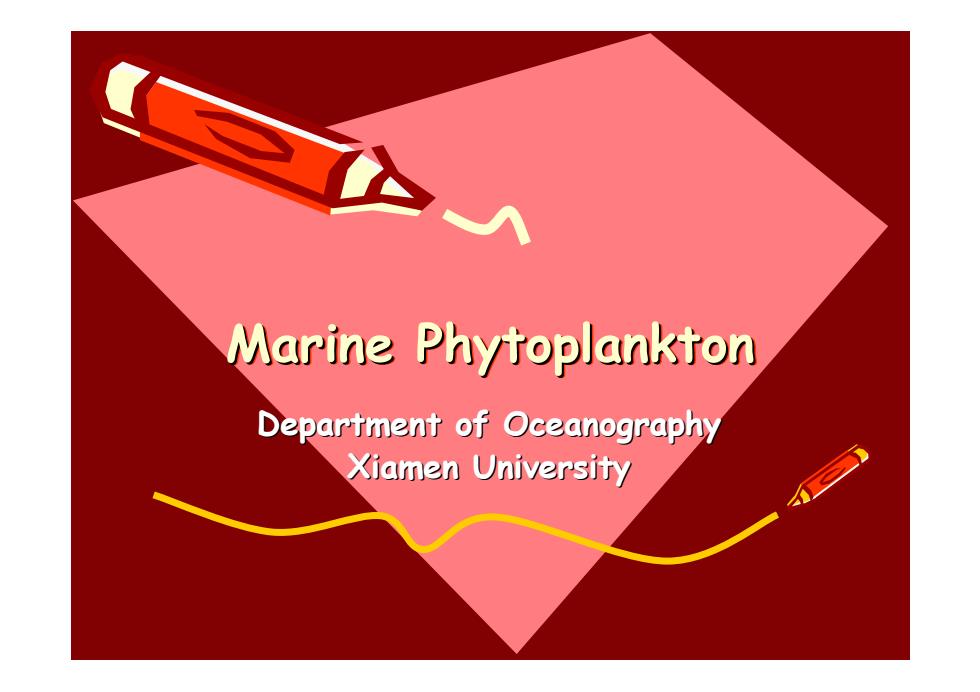
Marine Phytoplankton Marine Phytoplankton Department of Oceanography Department of Oceanography Xiamen University University
Marine Phytoplankton Marine Phytoplankton Department of Oceanography Department of Oceanography Xiamen University University
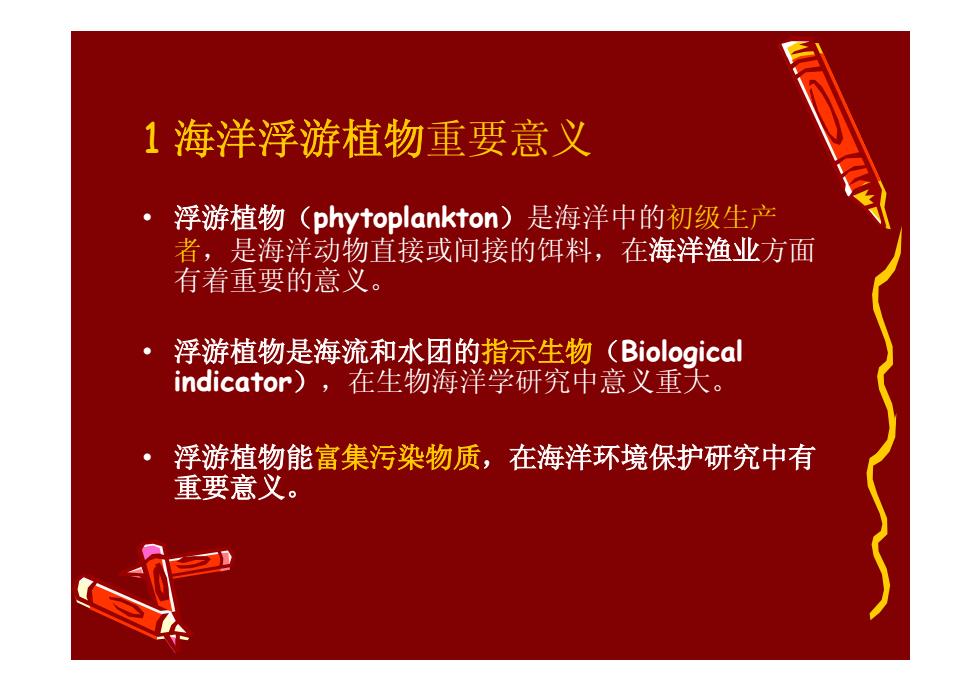
1 海洋浮游植物重要意义 • 浮游植物(phytoplankton)是海洋中的初级生产 者,是海洋动物直接或间接的饵料,在海洋渔业方面 有着重要的意义。 • 浮游植物是海流和水团的指示生物(Biological indicator),在生物海洋学研究中意义重大。 • 浮游植物能富集污染物质,在海洋环境保护研究中有 重要意义
1 海洋浮游植物重要意义 • 浮游植物(phytoplankton)是海洋中的初级生产 者,是海洋动物直接或间接的饵料,在海洋渔业方面 有着重要的意义。 • 浮游植物是海流和水团的指示生物(Biological indicator),在生物海洋学研究中意义重大。 • 浮游植物能富集污染物质,在海洋环境保护研究中有 重要意义
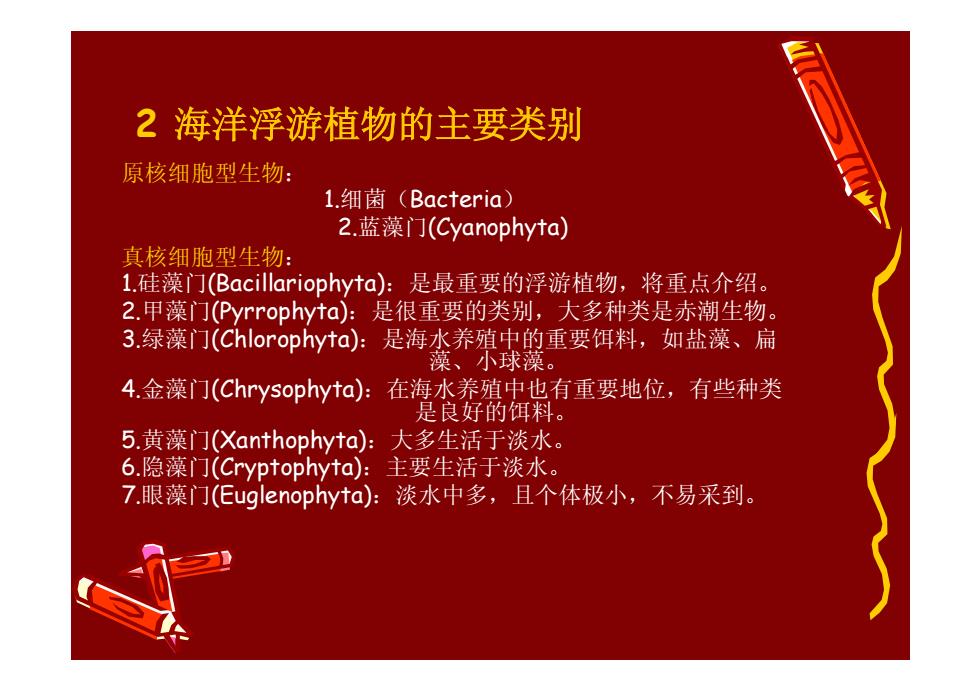
2 海洋浮游植物的主要类别 原核细胞型生物: 1.细菌(Bacteria ) 2.蓝藻门(Cyanophyta) 真核细胞型生物: 1.硅藻门(Bacillariophyta):是最重要的浮游植物,将重点介绍。 2.甲藻门(Pyrrophyta):是很重要的类别,大多种类是赤潮生物。 3.绿藻门(Chlorophyta):是海水养殖中的重要饵料,如盐藻、扁 藻、小球藻。 4.金藻门(Chrysophyta):在海水养殖中也有重要地位,有些种类 是良好的饵料。 5.黄藻门(Xanthophyta):大多生活于淡水。 6.隐藻门(Cryptophyta):主要生活于淡水。 7.眼藻门(Euglenophyta):淡水中多,且个体极小,不易采到
2 海洋浮游植物的主要类别 原核细胞型生物: 1.细菌(Bacteria ) 2.蓝藻门(Cyanophyta) 真核细胞型生物: 1.硅藻门(Bacillariophyta):是最重要的浮游植物,将重点介绍。 2.甲藻门(Pyrrophyta):是很重要的类别,大多种类是赤潮生物。 3.绿藻门(Chlorophyta):是海水养殖中的重要饵料,如盐藻、扁 藻、小球藻。 4.金藻门(Chrysophyta):在海水养殖中也有重要地位,有些种类 是良好的饵料。 5.黄藻门(Xanthophyta):大多生活于淡水。 6.隐藻门(Cryptophyta):主要生活于淡水。 7.眼藻门(Euglenophyta):淡水中多,且个体极小,不易采到
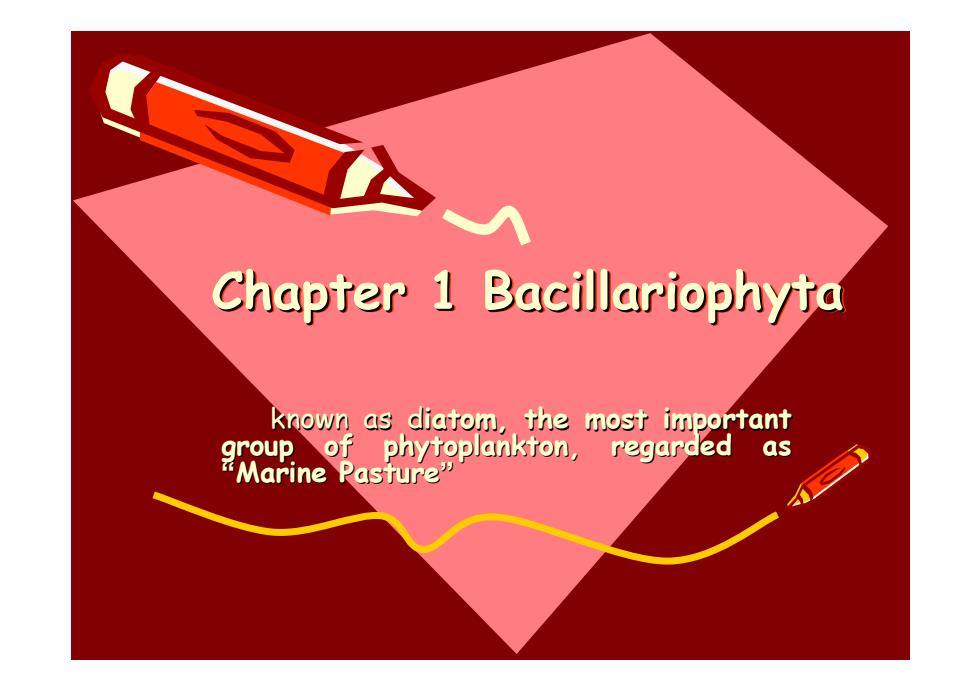
Chapter 1 Chapter 1 Chapter 1 Bacillariophyta Bacillariophyta Bacillariophyta known as d known as diatom, the most important iatom, the most important group of phytoplankton, regarded as group of phytoplankton, regarded as “Marine Pasture Marine Pasture
Chapter 1 Chapter 1 Chapter 1 Bacillariophyta Bacillariophyta Bacillariophyta known as d known as diatom, the most important iatom, the most important group of phytoplankton, regarded as group of phytoplankton, regarded as “Marine Pasture Marine Pasture
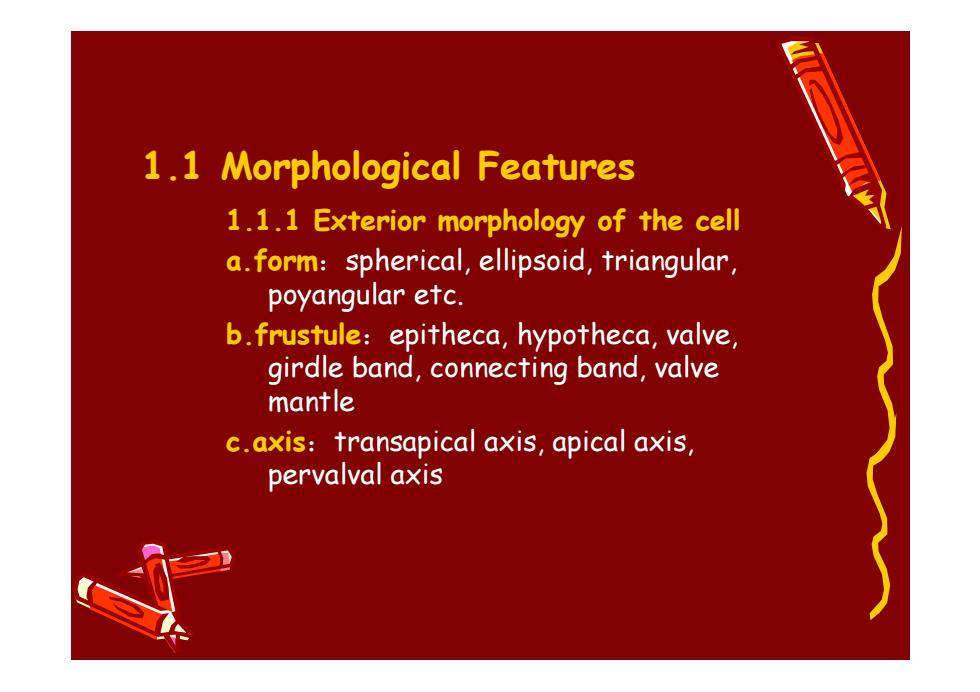
1.1 Morphological Features 1.1.1 Exterior morphology of the cell a.form:spherical, ellipsoid, triangular, poyangular etc. b.frustule:epitheca, hypotheca, valve, girdle band, connecting band, valve mantle c.axis:transapical axis, apical axis, pervalval axis
1.1 Morphological Features 1.1.1 Exterior morphology of the cell a.form:spherical, ellipsoid, triangular, poyangular etc. b.frustule:epitheca, hypotheca, valve, girdle band, connecting band, valve mantle c.axis:transapical axis, apical axis, pervalval axis
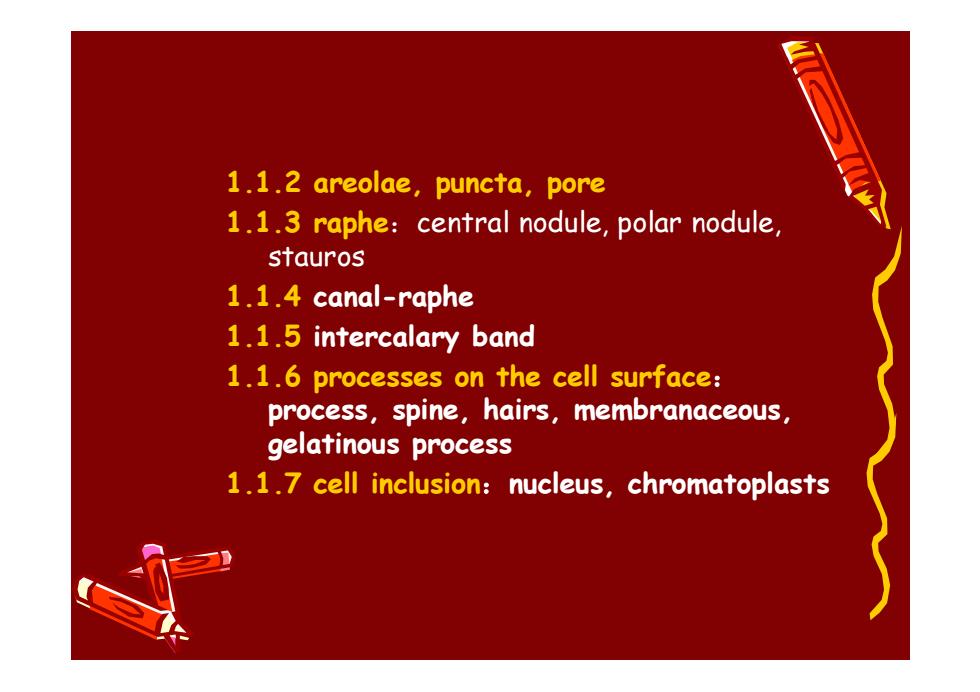
1.1.2 areolae, puncta, pore 1.1.3 raphe:central nodule, polar nodule, stauros 1.1.4 canal-raphe 1.1.5 intercalary band 1.1.6 processes on the cell surface: process, spine, hairs, membranaceous, gelatinous process 1.1.7 cell inclusion:nucleus, chromatoplasts
1.1.2 areolae, puncta, pore 1.1.3 raphe:central nodule, polar nodule, stauros 1.1.4 canal-raphe 1.1.5 intercalary band 1.1.6 processes on the cell surface: process, spine, hairs, membranaceous, gelatinous process 1.1.7 cell inclusion:nucleus, chromatoplasts
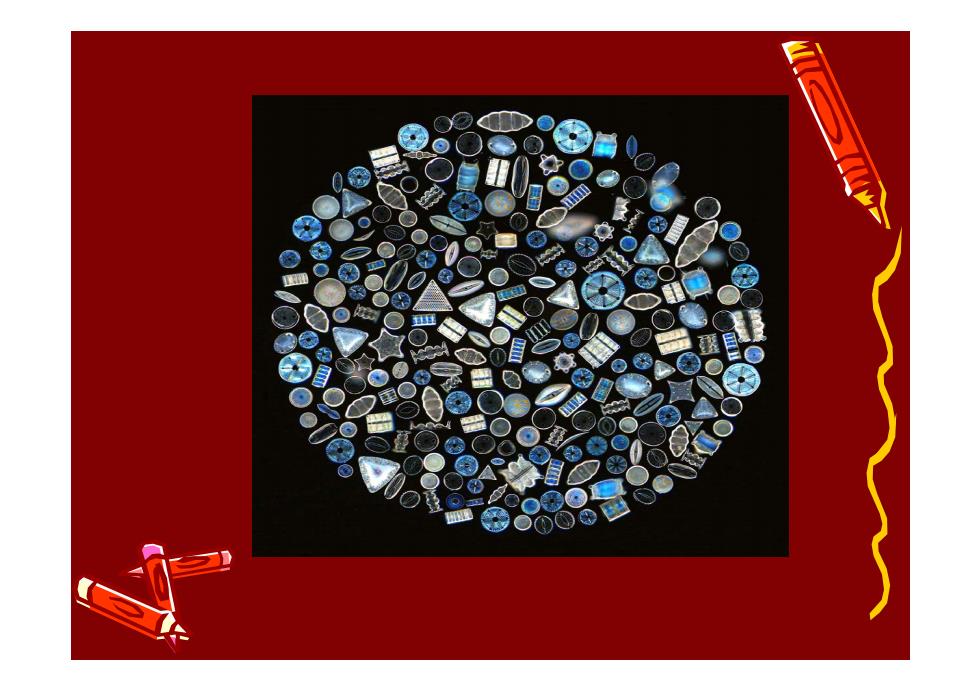
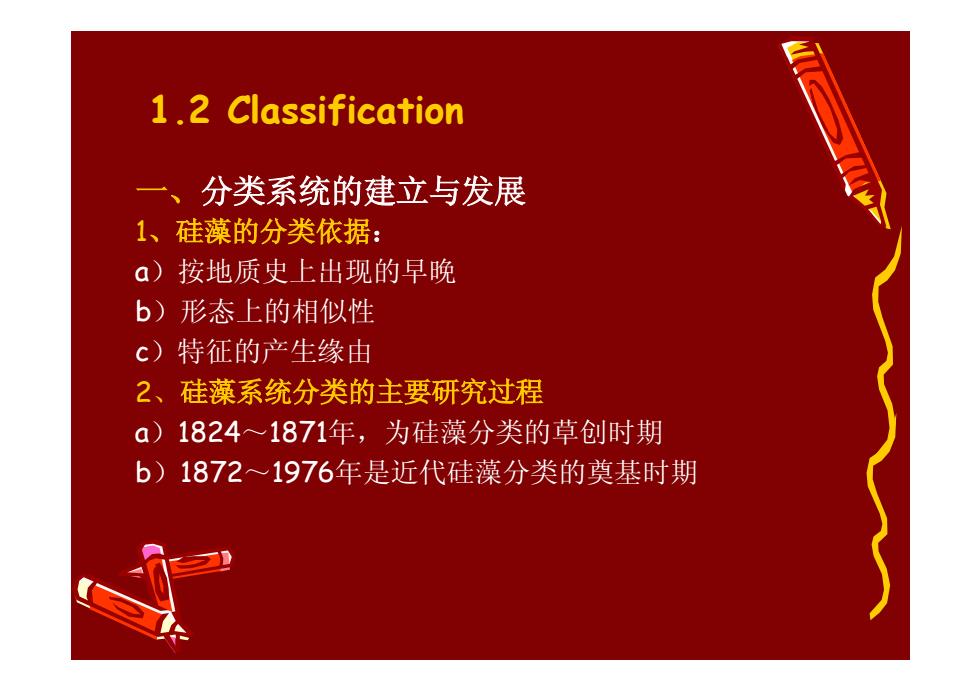
1.2 Classification 一、分类系统的建立与发展 1、硅藻的分类依据: a)按地质史上出现的早晚 b)形态上的相似性 c)特征的产生缘由 2 、硅藻系统分类的主要研究过程 a )1824 ~1871年,为硅藻分类的草创时期 b )1872 ~1976年是近代硅藻分类的奠基时期
1.2 Classification 一、分类系统的建立与发展 1、硅藻的分类依据: a)按地质史上出现的早晚 b)形态上的相似性 c)特征的产生缘由 2 、硅藻系统分类的主要研究过程 a )1824 ~1871年,为硅藻分类的草创时期 b )1872 ~1976年是近代硅藻分类的奠基时期
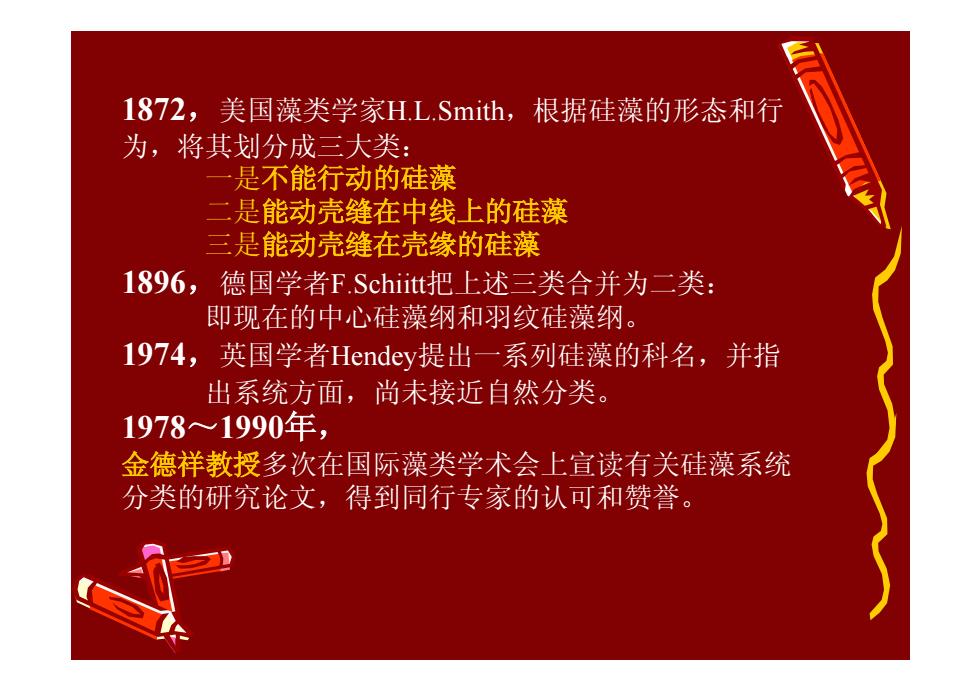
1872,美国藻类学家H.L.Smith,根据硅藻的形态和行 为,将其划分成三大类: 一是不能行动的硅藻 二是能动壳缝在中线上的硅藻 三是能动壳缝在壳缘的硅藻 1896,德国学者F.Schiitt把上述三类合并为二类: 即现在的中心硅藻纲和羽纹硅藻纲。 1974,英国学者Hendey提出一系列硅藻的科名,并指 出系统方面,尚未接近自然分类。 1978~1990年, 金德祥教授多次在国际藻类学术会上宣读有关硅藻系统 分类的研究论文,得到同行专家的认可和赞誉
1872,美国藻类学家H.L.Smith,根据硅藻的形态和行 为,将其划分成三大类: 一是不能行动的硅藻 二是能动壳缝在中线上的硅藻 三是能动壳缝在壳缘的硅藻 1896,德国学者F.Schiitt把上述三类合并为二类: 即现在的中心硅藻纲和羽纹硅藻纲。 1974,英国学者Hendey提出一系列硅藻的科名,并指 出系统方面,尚未接近自然分类。 1978~1990年, 金德祥教授多次在国际藻类学术会上宣读有关硅藻系统 分类的研究论文,得到同行专家的认可和赞誉

金德祥学术观点:中心硅藻比羽纹硅藻原始 长形、无壳缝(退化的结果) ^ 长形、部分壳缝消失 ^ 长形、能行动有壳缝的硅藻 ^ 圆形、能行动有壳缝的硅藻(羽纹硅藻初始类型) ^ 圆形、不能行动的硅藻(中心硅藻 )
金德祥学术观点:中心硅藻比羽纹硅藻原始 长形、无壳缝(退化的结果) ^ 长形、部分壳缝消失 ^ 长形、能行动有壳缝的硅藻 ^ 圆形、能行动有壳缝的硅藻(羽纹硅藻初始类型) ^ 圆形、不能行动的硅藻(中心硅藻 )